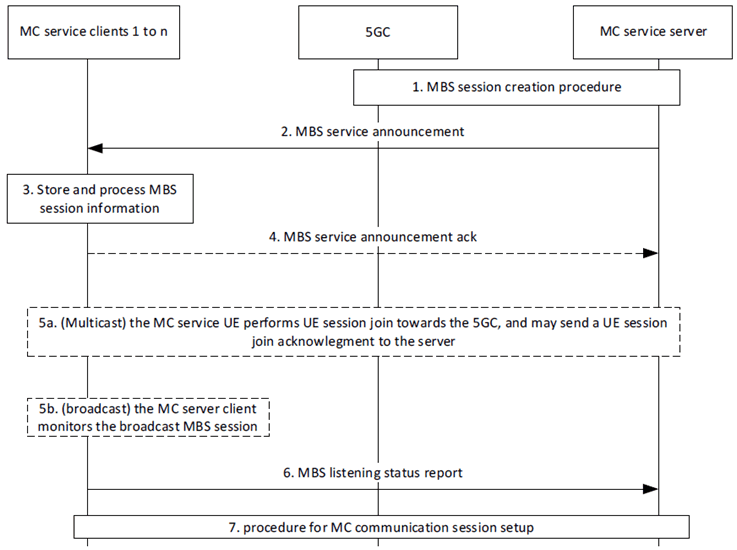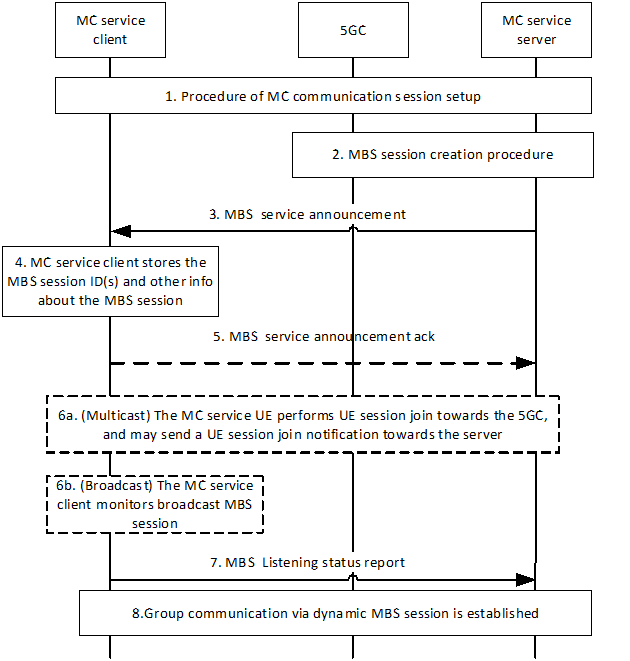Content for TS 23.289 Word version: 19.0.0
0…
4…
4.7…
4.7.4…
4.8…
5…
5.4…
6…
6.3…
6.3.2…
7…
7.2.4…
7.3…
7.3.3…
7.3.3.2…
7.3.3.4…
7.3.3.5…
7.3.3.7…
7.3.3.8…
7.3.3.9…
7.3.3.10…
7.3.3.11…
7.3.3.12…
7.3.3.13…
7.4…
7.5…
7.6…
A…
7.3.3 Procedures for usage of 5G MBS
7.3.3.1 MBS session creation and MBS session announcement
7.3.3.1.1 General
7.3.3.1.2 Procedure for pre-created MBS session and MBS session announcement
7.3.3.1.3 Procedure for dynamic MBS sessions
...
...
7.3.3 Procedures for usage of 5G MBS p. 57
7.3.3.1 MBS session creation and MBS session announcement p. 57
7.3.3.1.1 General p. 57
The procedures in this clause describe how MBS session creation and MBS session announcement can be used for the transmission of MC service group communication data over either broadcast or multicast MBS sessions. The MBS session can either be created with or without dynamic PCC rule, where the latter requires less interaction done by the MC service server towards the 5GC (either directly or via NEF).
7.3.3.1.2 Procedure for pre-created MBS session and MBS session announcement p. 58
Pre-conditions:
- The MC service server has decided to use an MBS session for MC service group communications associated to a certain MC service group based on transport only mode.
- The MC service server has performed MB-SMF discovery and selection either directly or indirectly, via NEF/MBSF, unless the corresponding information is locally configured.
- MC service clients 1 to n are attached to the 5GS, registered and affiliated to the same MC service group X.
- The MC service server is aware whether to request the creation of the MBS service server with or without dynamic PCC rule.

Step 1.
The MC service server initiates an MBS session creation procedure towards the 5GC as described in TS 23.247. The procedure starts once the MC service server initiates a TMGI allocation request (either directly to MB-SMF or indirectly via NEF). Upon the reception of the TMGI allocation response, the MC service server sends an MBS session creation request, including further information related to the MBS session, e.g., MBS session ID, MBS session mode and the QoS requirements if dynamic PCC rule is not considered. However, if dynamic PCC rule is considered, the MC service server defines these requirements at a later step, namely it sends an MBS authorization/policy create request towards PCF (either directly or to the NEF) indicating the QoS requirements.
Step 2.
The MC service server provides the MC service clients affiliated to MC service group X with the information related to the created MBS session via the MBS session announcement. As described in Table 7.3.2.1-1, the MBS session announcement includes information such as the MBS session ID, MBS session mode (broadcast or multicast service type) and SDP information related to the MBS session under consideration.
Optionally, the MC service server includes the information elements related to the established eMBMS bearer once the MC service server has determined the need, as indicated in Table 7.3.2.1-1. The MC service clients which camp on LTE will subsequently react to the information elements related to the eMBMS bearer as described in TS 23.280.
Step 3.
MC service clients store and process the received MBS session information.
Step 4.
MC service clients may provide an MBS session announcement acknowledgment to the MC service server to indicate the reception of the corresponding MBS session announcement.
Step 5.
Based on the MBS session mode (either multicast or broadcast), the following actions take place:
Step 5a.
For multicast MBS sessions, MC service clients initiate a UE session join request towards the 5GC using the information provided via the MBS session announcement. Hence, upon the first successful UE session join request, the multicast is then established, and the radio resources are reserved, if the session is in an active state. The established session can either be in active or inactive state as indicated in TS 23.247. The MC service clients sends a UE session join notification towards the server. If indicated in the MBS session announcement information, MC service clients report the monitoring state (i.e., the reception quality of the MBS session) back to the MC service server; or
Step 5b.
For broadcast MBS sessions, if the MC service client is accessing over 5G, the session is established as part of the session creation procedures as described in TS 23.247, and the network resources are reserved both in 5GC and NG-RAN. The MC service clients start monitoring the reception quality of the broadcast MBS session. If indicated in the MBS session announcement information, MC service clients report the monitoring state (i.e., the reception quality of the MBS session) back to the MC service server.
Step 6.
The MC service clients provide a listening status notification related to the announced session (multicast or broadcast session) in the form of an MBS listening status report.
Step 7.
7.3.3.1.3 Procedure for dynamic MBS sessions p. 59
In this scenario, the group communication is already taken place and a unicast PDU session is utilized for MC DL transmission. When the MC service server decides to use an MBS session for the transmission under consideration, the MC service server interacts with 5GC to reserve the necessary network resources.
The procedure in Figure 7.3.3.1.3-1 shows one MC service client receiving the DL media. There might also be MC service clients in the same MC group communication session that receive the communication on an MBS session.
Pre-conditions:
- MC service client is attached to the 5GS, registered and affiliated to a certain MC service group X.
- The MC service server is aware whether to request the creation of the MBS service server with or without dynamic PCC rule.
- The MC service server has performed MB-SMF discovery and selection either directly or indirectly, via NEF/MBSF, unless the corresponding information is locally configured.
- No MBS session exists, or the existing multicast MBS session fails to satisfy the QoS requirements.

Step 1.
An MC service group communication session is established as specified in TS 23.379, TS 23.281, or TS 23.282.
Step 2.
The MC service server decides to create an MBS session. The MBS session creation procedure takes place as described in clause 7.3.3.1.
Step 3.
The MC service server provides the MC service client with the information related to the created MBS session via an MBS session announcement. As described in Table 7.3.2.1-1, the session announcement includes information such as the MBS session ID, MBS session mode (broadcast or multicast service type), and SDP information related to the MBS session.
Optionally, the MC service server includes the information elements related to the established eMBMS bearer once the MC service server has determined the need, as indicated in Table 7.3.2.1-1. The MC service clients which camp on LTE will subsequently react to the information elements related to the eMBMS bearer as described in TS 23.280.
Step 4.
The MC service client stores the MBS session ID and other associated information.
Step 5.
The MC service client may send an MBS session announcement ack back to the MC service server.
Step 6.
Based on the MBS session mode (either multicast or broadcast), the following actions take place:
Step 6a.
For multicast MBS sessions, MC service client initiates a UE session join request towards the 5GC using the information provided via the MBS session announcement. Hence, upon the first successful UE session join request, the multicast is then established, and the radio resources are reserved, if the session is in active state. The established session can either be in active or inactive state as indicated in TS 23.247. The MC service client sends a UE session join notification towards the server. If indicated in the MBS session announcement information, MC service clients report the monitoring state (i.e., the reception quality of the MBS session) back to the MC service server; or
Step 6b.
For broadcast MBS sessions, if the MC service client is accessing over 5G, the session is established as part of the session creation procedures as described in TS 23.247, and the network resources are reserved both in 5GC and NG-RAN. The MC service clients start monitoring the reception quality of the broadcast MBS session. If indicated in the MBS session announcement information, MC service clients report the monitoring state (i.e., the reception quality of the MBS session) back to the MC service server.
Step 7.
The MC service clients provide a listening status notification related to the announced session (multicast or broadcast session) in the form of an MBS listening status report.
Step 8.
An MC service group communication via dynamic MBS session is established.